Romantic Spain: David Roberts and Genaro Pérez Villaamil
Reviewed by Javier Ortiz-EchagüeJavier Ortiz-Echagüe
Universidad Rey Juan Carlos
Email the author: javier.echague[at]urjc.es
Citation: Javier Ortiz-Echagüe, exhibition review of Romantic Spain: David Roberts and Genaro Pérez Villaamil, Nineteenth-Century Art Worldwide 21, no. 3 (Autumn 2022), https://doi.org/10.29411/ncaw.2022.21.3.28.
This work is licensed under a Creative Commons Attribution-NonCommercial 4.0 International License  unless otherwise noted.
unless otherwise noted.
Your browser will either open the file, download it to a folder, or display a dialog with options.
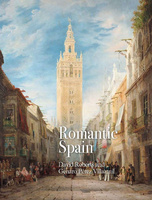
Romantic Spain: David Roberts and Genaro Pérez Villaamil.
Real Academia de Bellas Artes de San Fernando, Madrid,
October 7, 2021–January 16, 2022
Claudia Hopkins, ed.,
Romantic Spain: David Roberts and Genaro Pérez Villaamil.
Madrid: Real Academia de Bellas Artes de San Fernando, Centro de Estudios Europa Hispánica, Instituto Ceán Bermúdez, 2021.
512 pp.; 285 color illus.; bibliography.
€43,27
ISBN: 978–84–18760–03–7
A lithograph published in Germany in 1860 shows some thirty figures in traditional dress in front of a palace featuring a coat of arms and Gothic-style windows on the façade (fig. 1). The image is entitled Platz bei Alhambra (Square at the Alhambra), but nothing recalls the style of Nasrid architecture nor the characteristic views of the city of Granada. Romantic Spain, the exhibition curated by Claudia Hopkins at the Real Academia de Bellas Artes de San Fernando in Madrid, has rediscovered this image and traced its origin. It is based on a lithograph entitled La plaza de los Momos en Zamora published in the third volume of Genaro Pérez Villaamil’s album España Artística y Monumental (1850, fig. 2). Ten years later, Joseph Scholz’s publishing house in Mainz decided to appropriate this image and republish it with modifications. The change of the title may have been motivated by Scholz’s desire to cater to the expectations of his public. Replacing “Zamora,” a town in central Spain, with the “Alhambra” in the south, indicates the extent to which European audiences conflated Spain with Andalusia and, more specifically, Nasrid Spain. More than a trivial anecdote, the retitling of the print reflects how northern audiences commonly exoticized Spanish culture.[1]
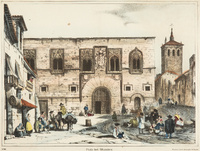
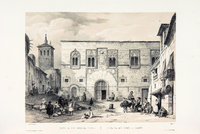
In the Romantic era the country became a fashionable destination for artists and writers as part of a wider interest in the so-called “Orient”: North Africa, the Maghreb, and the Middle East. As a result, by the mid-century a romanticized image of Spain (exotic, picturesque, folkloric, ultra-Catholic, backward, etc.) was so commonplace that some authors even doubted the need to make the uncomfortable journey in order to write about the country. In his Voyage en Espagne (1845), the French author Théophile Gautier recalled an ironic comment made to him by the poet Heinrich Heine before embarking on his trip to Spain: “How will you manage to speak of Spain after you have been there?”[2] Spain had already become an “idea” by then, a setting readily available to writers and painters, regardless of direct knowledge of its reality. As Romantic Spain shows, the Scottish landscape painter David Roberts (1796–1864) and his Spanish counterpart Genaro Pérez Villaamil (1807–54) were key players in forging a romanticized vision of the country.
Hispanists continue to engage with the issues surrounding the construct of Spain. Most nineteenth-century foreign art writers considered that the great tradition of Spanish painting had ended with Goya and therefore had little interest in living Spanish artists.[3] Such attitudes partly explain why art historians today continue to relegate nineteenth-century Spanish artists, such as Villaamil, to a marginal position within the narrow canon of nineteenth-century art, which has its capital in Paris.[4]
Romantic Spain addresses the issue of “Spanishness” by examining the artistic dialogue between Roberts and Villaamil. Both of them were leading figures on the artistic scene of their time. Roberts was the first professional British landscape painter to travel in Spain and the Middle East. Villaamil was the founder of the Spanish landscape school, painter to Queen Isabella, and one of Spain’s most international artists of the nineteenth century, whose premature death was described as a “calamity for the arts.”[5] The two met in Seville in the summer of 1833 and maintained personal contact from that time onwards. At first sight, Roberts’s influence on Villaamil seems clear. It is sufficient to compare, as the exhibition suggests, The Castle of Alcalá de Guadaira (1833) by Roberts, now in the Museo del Prado, with the copy by Villaamil in the Carmen Thyssen-Bornemisza collection. From this comparison, it is possible to think that Villaamil was no more than a discreet imitator of Roberts’s landscapes, an idea promoted by foreign writers during the artist’s lifetime.[6] Other paintings on Sevillian themes (such as the views of the Seville cathedral by both artists, figs. 3–4) confirm this interpretation, in which the Spanish painter appears as an emulator of Roberts’s style based on the conventions of the Picturesque and the Sublime. To some extent, then, he identified with Roberts’s vision, seeing his own country through foreign eyes.
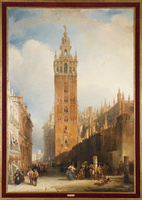
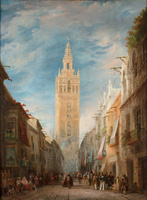
Romantic Spain challenges the facile view of Villaamil as a mere imitator, which is based exclusively on the stylistic dependence shown in the initial contact between the two artists. Considering their relationship across two decades allows us to observe similarities but also important differences between Roberts and Villaamil. These are articulated around six sections that make up both the exhibition and its carefully crafted and generously illustrated catalogue, published by the Centro de Estudios Europa Hispánica. The book includes six extensive, scholarly essays and detailed catalogue entries, mostly written by Claudia Hopkins. Two essays are by Matilde Mateo (“Pleasures of the Imagination”) and Andrew Ginger (“Looking Forward”), and the following scholars are (co-) authors of some of the 120 catalogue entries: Antonio Gámiz Gordo, Antonio Jesús García Ortega, Celia Jiménez Bellido, Briony Llewellyn, Krystyna Matyjaszkiewicz, Luis Ruiz Padrón, Carlos Sánchez, Danielle Smith, and Martin P. Sorowka.
The first section is a general introduction to Roberts and Villaamil and the broader context of the cultural discovery of Spain after the Peninsula War; the second, “Seville, Summer 1833,” demonstrates how Villaamil changed his style as a consequence of his encounter with Roberts. The third section, entitled “Inventing and Popularising the Spanish Picturesque,” examines the transformation of on-the-spot drawings into more elaborate images, which were turned into lithographs and steel engravings. Going beyond an examination of individual paintings, this section is particularly interesting as it explores the invention, dissemination, and social impact of the artists’ Spanish-themed images. The abundance of printed materials is undoubtedly one of the most remarkable points of Romantic Spain. Sometimes, it allows us to follow the trajectory of a specific picture in different media, as in the case of Roberts’s watercolor A Bullfight at Seville (ca. 1836), which was reproduced as a lithograph in the 1837 volume Picturesque Sketches in Spain Taken During the Years 1832 & 1833 (fig. 5), and reappears ca. 1845 on a ceramic plate produced by William Adams & Sons in Staffordshire (fig. 6). Such a simple juxtaposition effectively demonstrates how images proliferated across different media before Walter Benjamin’s “age of mechanical reproduction.” Prints helped consolidate the romanticized ideas of Spain that were forged in the emerging travel literature at the time, such as Thomas Roscoe’s volumes of The Tourist in Spain (3 vols., 1835–37) and The Tourist in Spain and Morocco (1838). These were all illustrated with engravings after Roberts’s drawings, several years before the publication of Richard Ford’s seminal guidebook, Hand-Book for Travellers in Spain and Readers at Home (1845).
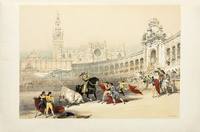
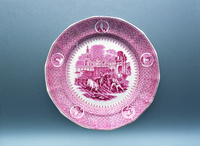
Like Roberts, Villaamil too turned his drawings into prints, notably in his large-format album España Artística y Monumental, published in Paris in three volumes (1842, 1844, and 1850). Most lithographs are based on drawings by Villaamil himself, and Patricio de la Escosura is the author of a bilingual Spanish-French commentary. An international enterprise, the ambition was to showcase Spain’s historic monuments to a European audience. Differences between Robert and Villaamil begin to emerge here in terms of their focus, as the latter omits the Alhambra, the most popular monument amongst foreign travelers, and mostly focuses on central and northern Spain. Like Roberts’s prints, Villaamil’s lithographs also migrated into other formats. For instance, the plate entitled Arab Ruins in Humanejos (1850) is one of eight plates appropriated for the Illustrated Handbook of Architecture (1855) by the Scottish historian James Fergusson. These cases exemplify the international dissemination of Roberts’s and Villaamil’s pictures and their contribution to the diffusion of a particular vision of “romantic Spain.”
Both artists subscribed to an idealized vision of al-Andalus, which is the theme of the fourth section “From Al-Andalus to the East.” Perhaps “Moorish Spain” was Roberts’s favorite Spanish theme. He mostly focused on southern Spain, where the remnants of the Islamic past are best preserved. Amongst the works on display, his large Fortress of the Alhambra (1838) stands out: a vast panoramic view of the Nasrid palaces, seen from the Albaicín hill against the snowy peaks of the Sierra Nevada. The view looks plausible, but upon closer inspection, we notice how Roberts manipulated the perspective and invented and relocated some of the buildings. In the foreground, figures in traditional dress, flirting and dancing, add a local flavor. His timeless vision of picturesque Granada and bygone splendor stands in sharp contrast with Villaamil’s Orientalist picture hanging on the opposite wall, an Orientalist interior entitled The Oath of Alvar Fáñez de Minaya (1847) commissioned by the Spanish Queen Isabella II. Unlike Roberts, Villaamil alludes to a specific moment in early eleventh-century Toledo: King Alfonso VI’s loyal captain Alvar Fañez de Minaya is depicted taking an oath amongst a crowd of Christians, Muslims, and Jews at a time of Almoravid invasions. Villaamil’s setting does not however correspond to a specific Toledan palace but is based on a combination of sources. The palatial interior recalls elements of the Alhambra in Granada and the Alcazar of Seville, but the urban landscapes visible through the arches on the left are inspired by David Roberts’s images of Egyptian mosques, published in The Holy Land, Syria, Idumea, Arabia, Egypt & Nubia (6 vols., 1842–49). In other words, Villaamil’s Orientalist picture is a fantasy of medieval history, inviting reflection on the “Reconquista” in which the Toledan monarchs played a vital role. The theme was a deliberate gesture, as the painter was well acquainted with Toledo’s history and architecture, to which he devoted many images in his España Artística y Monumental and the Diptych with 42 Monumental Views of Spanish Cities (1835–39), now in the Museo del Prado.
The differences emerging in Villaamil’s and Roberts’s approaches to al-Andalus are further defined in the fifth section “The Past as a National Fantasy,” which explores the artists’ interests in central and northern parts of Spain. Here, Roberts loses prominence, as his vision of Spain favored Andalusia over other parts of the country. Villaamil, on the other hand, broke new ground with pictures of landscapes and architecture neglected by Roberts and other foreign travelers. His most evocative painting is the spectacular Procession in Covadonga (1851), commissioned by the Queen of Spain. It offers a plunging view of Asturian pilgrims and a procession in Covadonga, the site where, according to tradition, the Virgin had appeared to Pelayo, the first Christian king to defeat the invading Muslims only a few years after the invasion, in the early eighth century. Pelayo thus became the founder of the Spanish monarchy, defined as Christian by the struggle against Islam. Villaamil’s vision of history is spelled out in the inscription in the lower right-hand corner of the painting: “Commemoration of the battle of Covadonga and the origin of the Spanish monarchy.” Villaamil’s landscape however refrains from the triumphalist rhetoric that is found in history painting in the mid-century. The figure of Pelayo became a recurring subject: suffice it to recall that in 1847 José de Madrazo, director of the then Royal Museum of Paintings (now the Prado Museum), began to prepare the Chronological Series of the Kings of Spain, a collection of portraits of monarchs, beginning precisely with Don Pelayo, King of Asturias (1853–56) by Luis de Madrazo y Kuntz and ending with a portrait of Queen Isabella II. At the same time, at the newly established National Exhibition of Fine Arts in Madrid, the first medal was awarded to Don Pelayo in Covadonga (1855) by the same painter.[7] In this context Villaamil’s approach differs. His awe-inspiring landscape, painted in loose, thick brushstrokes, caters to the aesthetics of the sublime; the multitude of pilgrims are reminiscent of the crowds in some of Goya’s paintings. Villaamil’s is not a history painting in the strict sense of the word. It depicts a contemporary pilgrimage to a “realm of memory” in nineteenth-century nationalism.[8]
The final section, entitled “Progress and Modernity,” is innovative as it goes beyond previous studies of Romantic artist-travelers in Spain. The notion of progress was central to nineteenth-century thought, as the exhibition confirms. The artists’ interest in fashioning an image of Spain based on its ancient monuments and popular traditions developed against a background of urban and industrial development. Roberts engaged with modernity only in the context of his own country: new bridges, trains, and buildings in London and Edinburgh. Villaamil in turn devoted two significant paintings to the modernization of Spain. View of the Town of Fraga and its Suspension Bridge (1850) shows a Goyaesque crowd under the new bridge that had only been inaugurated three years before. His Inauguration of the Langreo Railway by the Queen Regent (1852) depicts the opening ceremony of this railway built for the transportation of coal. It is the first oil painting of a railway in Spain. Despite its novel subject matter, the painting was not successful when it was shown at the Universal Exhibition in Paris in 1855. The French critics ignored it as they invariably favored a “picturesque” over a “modern” Spain. Yet, such works reveal the other side of the coin of the Romantic image of Spain, which is more complex than hitherto assumed. The nineteenth century is not only the century of the “invention of tradition,” in Eric Hobsbawm and Terence Ranger terms.[9] It is also the time of the “invention of the future.”[10]
To contextualize the artists’ interests in new technologies and transportation, Romantic Spain includes a range of material, such as a photographic view of The Construction of the Puente de los Franceses (1859) in Madrid by the British photographer Charles Clifford. This reference directly resonates with the exhibition Clifford. Views of Isabel II’s Madrid, on display at the Fundación Canal in Madrid at the same time as Romantic Spain. It is dedicated to Clifford’s photographs of Madrid, where he lived between 1850 and 1863. They show the city’s transformation thanks to the great engineering projects of the time—essentially the construction of the railway and the canal supplying the city with fresh water.[11] But photographs are not simply a way of documenting material progress. Visual technology, from daguerreotype to the moving image, would radically transform the production, dissemination, and reception of pictures across the nineteenth century. And photography is one key element in this process.[12]
Romantic Spain is an ambitious project for the works it brings together and the arguments it generates around them. It is also an opportunity to rescue two important artists from oblivion. In Spain, interest in Villaamil was timidly revived in 2014, when the Museo del Prado purchased the Diptych of 42 Views of Spanish Cities from the descendants of George Villiers, the British ambassador in Madrid between 1835 and 1839. However, Villaamil remains an unknown figure outside of Spain. In the case of Roberts, who is more internationally recognized, the last major exhibition of his work was held at the Barbican Art Gallery in London in 1986.[13] This neglect alone may be enough to justify the interest in exhibiting the work of the two artists. But interestingly, Romantic Spain goes beyond a mere rescue-operation. It departs from previous, more conventional studies of foreign Romantic artist-travelers in Spain by deliberately adopting a transnational perspective. It is an original case study of both cross-cultural influence and national identity formation. The arguments range from the influence of British landscape painting on Spanish painters to the circulation of images in the form of reproductions, the inclusion of Spain in European Orientalism, the Spanish attempt to speak back to orientalist clichés and to shift attention to other areas of Spanish geography beyond Andalusia, and the close relationship between technological progress and tradition. All these topics show that the history of nineteenth-century art is a rich and complex field if one makes the effort to look beyond the usual works and figures of the narrow French-centric canon of modernity.
Notes
[1] Francisco Calvo Serraller, La Imagen Romántica de España. Arte y Arquitectura del Siglo XIX (Madrid: Alianza, 1995), 19–29.
[2] Théophile Gautier, “Travels in Spain,” in The Complete Works of Théophile Gautier, vol. 2 (London: The Athenaeum Press, 1901), 17.
[3] Maxime du Champ, “En matières artistiques . . . l’Espagne n’existe plus,” in Les Beaux-Arts a l’Exposition Universelle de 1855. Peinture, Sculpture (Paris: Typ. de Pillet fils ainé, 1855), 340.
[4] Andrew Ginger, Painting and the Turn to Cultural Modernity in Spain: The Time of Eugenio Lucas Velázquez (1850–1870) (Selinsgrove: Susquehanna University Press, 2007), 14–15; Andrew Ginger, Instead of Modernity: The Western Canon and the Incorporation of the Hispanic (ca. 1850–1875) (Manchester: Manchester University Press, 2020), 5–6; M. Elizabeth Boone, “The Spanish Element in Our Nationality”: Spain and America at the World’s Fairs and Centennial Celebrations, 1876–1915 (University Park: Penn State University Press, 2019), 4.
[5] “Crónica de la capital,” El Clamor Público. Periódico del Partido Liberal, June 7, 1854, 3.
[6] “An imitator, at a respectful distance, of David Roberts, whose charming landscapes and architecture have long been to his continental colleagues at once a model and a stumbling block,” Richard Ford, “Spanish Architecture,” The Quarterly Review 77, no. 154 (1846): 500.
[7] José Álvarez Junco, Mater Dolorosa. La idea de España en el Siglo XIX (Madrid: Taurus, 2001), 253.
[8] On Covadonga as a “realm of memory,” see Carolyn P. Boyd, “The Second Battle of Covadonga: The Politics of Commemoration in Modern Spain,” History and Memory 14, nos. 1–2 (Spring-Winter 2002): 37–64.
[9] Eric Hobsbawm and Terence Ranger, The Invention of Tradition (Cambridge: Cambridge University Press, 1983).
[10] Bernardo Riego, “La Invención del Futuro y sus Orígenes Contemporáneos,” in La création Artistique Hispanique à l’Épreuve de l’Utopie, ed. Marie-Linda Ortega (Toulouse: Lansman, 2009), 79–102.
[11] Javier Ortiz-Echagüe, Clifford. Vistas del Madrid de Isabel II (Madrid: Fundación Canal, 2021).
[12] A pioneering analysis in this regard is in Jonathan Crary, Techniques of the Observer: On Vision and Modernity in the Nineteenth Century (Cambridge, Massachusetts: MIT Press, 1990).
[13] Helen Guiterman and Briony Llewellyn, David Roberts (Oxford: Phaidon Press, 1986).